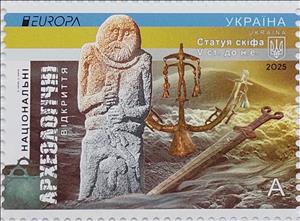Stamp: Europa (C.E.P.T.) 2025 - Statue of Scythian, 5th Century BCE (Ukraine 2025)
Europa (C.E.P.T.) 2025 - Statue of Scythian, 5th Century BCE (Ukraine 2025)
15 August (Ukraine ) within release Europa (C.E.P.T.) 2025 - Statue of Scythian, 5th Century BCE goes into circulation Stamp Europa (C.E.P.T.) 2025 - Statue of Scythian, 5th Century BCE face value A No Face Value
| Stamp Europa (C.E.P.T.) 2025 - Statue of Scythian, 5th Century BCE in catalogues | |
|---|---|
| Colnect codes: | Col: UA 2025.08.15-01 |
Stamp is horizontal format.
Face value US$1.20 on day of issue.Also in the issue Europa (C.E.P.T.) 2025 - Statue of Scythian, 5th Century BCE:
- Full Pane - Europa (C.E.P.T.) 2025 - Statue of Scythian, 5th Century BCE face value 4*A;
- Stamp - Europa (C.E.P.T.) 2025 - Statue of Scythian, 5th Century BCE face value A;
Stamp Europa (C.E.P.T.) 2025 - Statue of Scythian, 5th Century BCE it reflects the thematic directions:
Archaeology or archeology[a] is the study of human activity through the recovery and analysis of material culture. The archaeological record consists of artifacts, architecture, biofacts or ecofacts, sites, and cultural landscapes. Archaeology can be considered both a social science and a branch of the humanities. It is usually considered an independent academic discipline, but may also be classified as part of anthropology (in North America – the four-field approach), history or geography
A statue is a free-standing sculpture in which the realistic, full-length figures of persons or animals are carved or cast in a durable material such as wood, metal or stone. Typical statues are life-sized or close to life-size. A sculpture that represents persons or animals in full figure, but that is small enough to lift and carry is a statuette or figurine, whilst those that are more than twice life-size are regarded as colossal statues.
A sword is an edged, bladed weapon intended for manual cutting or thrusting. Its blade, longer than a knife or dagger, is attached to a hilt and can be straight or curved. A thrusting sword tends to have a straighter blade with a pointed tip. A slashing sword is more likely to be curved and to have a sharpened cutting edge on one or both sides of the blade. Many swords are designed for both thrusting and slashing. The precise definition of a sword varies by historical epoch and geographic region.



